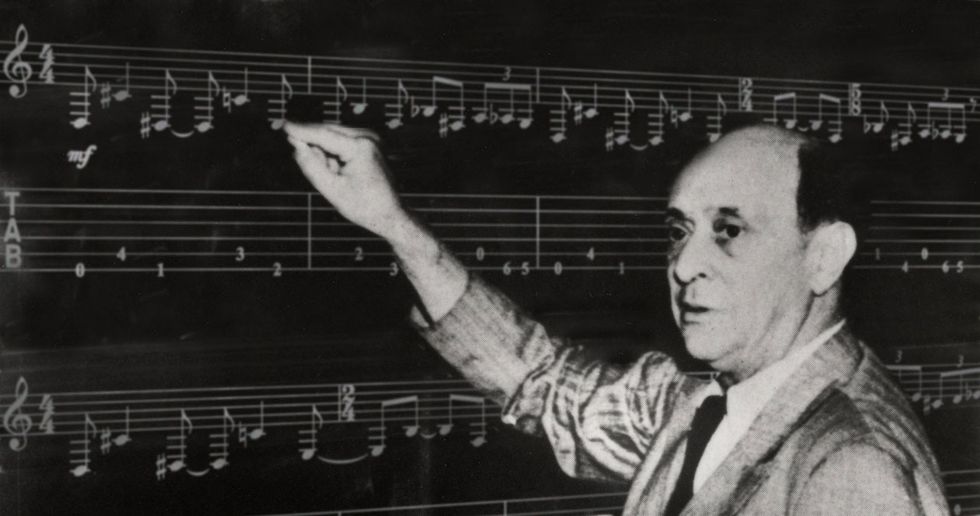Theory: Advanced
Lesson Overview:
• Learn about composition techniques from 20th-century classical music.
• Explore these techniques from a rock perspective.
• Study these subjects further with contemporary classical compositions. Click here to download a printable PDF of this lesson's notation.
Although 20th-century Western classical music may seem cold and cerebral to a lot of guitarists, many of its techniques can be—and have been—incorporated into popular music. In this lesson, we’ll explore seven techniques used by European and American composers of the 20th century and see how they translate to a rock setting. Often these techniques are also found in non-academic and non-Western music, so don’t be surprised if you’ve heard them somewhere else. My goal is to merely introduce you to these tools, so I can’t cover all their nuances and variations, but if you’re interested in learning more about them, start by listening to the composition listed at the end of each section.
The Whole-Tone Scale
In this six-note scale, the interval between each consecutive note is a whole-step. In Ex. 1, the scale I’m using is E–F#–G#–A#–C–D. Although the riff is built around E, the whole tone scale’s tonal center is pretty ambiguous because any note of the scale can be considered the root. This means there are only two different whole-tone scales to learn.
Click here for Ex. 1
“Voiles” by Claude Debussy
The Octatonic Scale
These scales are known by a few different names and are also commonly used in jazz improvisation. For our purposes, we will think of two variations: the half-whole diminished scale and the whole-half diminished scale. In Ex. 2, I use the whole-half version starting on A (A–B–C–D–Eb–F–F#–G#). If we flip around the half-steps and whole-steps we land on the half-whole diminished scale: A–Bb–C–Db–Eb–E–F#–G. The chromatic character of the scale has an unsettling sound and, similarly to the whole-tone scale, creates a less stable tonal center.
Click here for Ex. 2
Mikrokosmos Sz. 107, BB 105, Vol. 4: No. 101. Diminished Fifth
Polytonality
This happens when two or more keys sound at the same time. Ex. 3 begins with an unaccompanied melody in B Mixolydian (B–C#–D#–E–F#–G#–A). The second time the melody is played, the second guitar and bass come in with a countermelody in F major. Because of the two clashing tonal centers, the combination of the melodies sounds much more complex and interesting than each line on its own.
Click here for Ex. 3
Violin Sonata No. 2, Second Movement “Blues”by Maurice Ravel
Quartal Harmony
Quartal and quintal harmony uses chords built by stacking fourths or fifths, respectively, instead of thirds. In Ex. 4, all chords can be spelled using fourths, but not all of them have been voiced in that way. For example, the fourth and fifth chords (F–Bb–Eb and Eb–Bb–F) share the same notes but they are arranged differently. The absence of thirds gives quartal chords an open and ambiguous character while still sounding relatively consonant.
Click here for Ex. 4
“Mathis der Maler”: II. Grablegung (The Entombment) by Paul Hindemith
12-Tone Rows
In a 12-tone row (or 12-tone series), all 12 notes of the chromatic scale appear once, and no note can be used twice. With the 12-tone system it is possible to make music in which no note sounds more often than the others and therefore there is no tonal center. The riff in Ex. 5 uses the row D–C#–D#–C–E–B–F–Bb–F#–A–Ab–G. The row starting in measure 9 is a variation of the main one, constructed by inverting all intervals (meaning that the direction of each interval has been reversed) and transposing the row up by a diminished fourth and an octave.
Click here for Ex. 5
Wind Quintet, Op. 26 by Arnold Schoenberg
Phasing
With phasing, a short pattern is simultaneously played on two instruments, and then one of them moves out of sync with the other one. In Ex. 6, after the pattern is played once (measures 1 and 2), it is delayed by one eighth-note on the second guitar. This process continues until the pattern lines up in both guitars after being played 15 times. Phasing can also be achieved by shifting the pattern gradually instead of by a specific note value (this is much harder to perform). In Ex. 6, while the process happens in the two guitars, the bass and drums change every couple of measures to create different sections.
Click here for Ex. 6
“Clapping music” by Steve Reich
Nested Tuplets
A nested tuplet is simply a tuplet inside a tuplet. In Ex. 7, there are quintuplets in measures 2, 4, 6, and 7. In the first three cases, instead of dividing the 4/4 measure into four quarter-notes, we play five notes of the same length (a quarter-note quintuplet). In measure 7, the first note of the quintuplet is subdivided into three equal parts, creating an eighth-note triplet inside the quarter-note quintuplet. Nested tuplets are great for achieving complex and multi-layered rhythms, and although they can look intimidating at first, they feel much more fluid and natural once you get used to them.
Click here for Ex. 7
String Quartet No. 2 by Brian Ferneyhough
Where to Go from Here?
If you enjoyed this lesson, keep researching and experimenting. There are great resources inside and outside of academia to learn about modern music and the tools that composers use to write it. Setting rules for yourself won’t guarantee that you’ll create better music, but it will push you out of your comfort zone and force you to reach new places creatively.

















